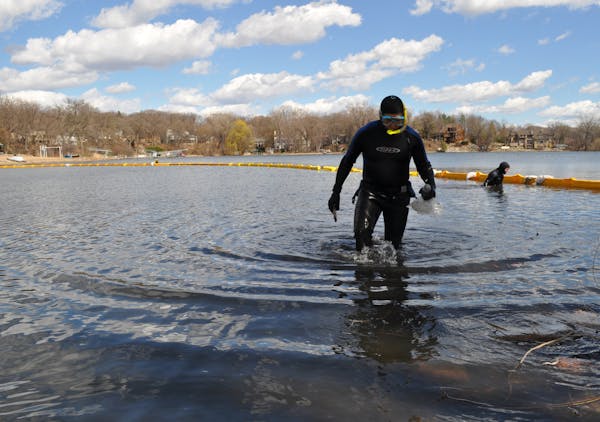In a setback in the battle against invasive species, state officials are halting treatments to eradicate zebra mussels in the west metro's Christmas Lake following a discovery that experimental chemicals failed to stop the mollusks from reproducing.
The Minnesota Department of Natural Resources (DNR) confirmed Friday that 16 zebra mussels were found in the Shorewood lake despite ongoing chemical treatments. Department officials called the discovery as a disappointment and a lesson for future eradication efforts.
Christmas Lake became a testing ground for researchers who are experimenting with ways to stop the species from invading local bodies of water. In 2014, Christmas Lake was the first in the nation to try a dead-bacteria cell product called Zequanox. Crews then followed with copper and 1,000 pounds of potassium chloride, or potash.
"Through each of the treatments applied to Christmas Lake, we learned valuable lessons about how to target organisms, how to effectively remove them, kill them from a water body," said Keegan Lund, aquatic invasive species specialist for the DNR.
It was the third time scientists have used potash in the United States to treat zebra mussels, and the first time it was used under ice, said Craig Dawson, program manager for aquatic invasive species at the Minnehaha Creek Watershed District.
The project was a joint effort of the Minnehaha Creek district, the DNR, the University of Minnesota, the city of Shorewood and the Christmas Lake Homeowners Association.
Aquatic specialists received special emergency permission to use the chemical treatments before the mussels could further disperse in the lake.
"Given the biology of the infestation, we knew the treatment this past July was our last, best chance to kill all the remaining zebra mussels in Christmas Lake," said Joe Shneider, president of the homeowners association. "And we had our fingers crossed that it would in fact do that."
The scientists found that each treatment killed all zebra mussels nearby, but that zebra mussels next to the treatment area survived. Crews expanded the treatment areas and, while results first appeared encouraging, on Monday more mussels were found by a local business removing a boat lift on the southwest corner of the lake, south of the public access area.
A follow-up inspection found the mussels dispersed around the lake. Given the spread and age of the mussels, both groups decided to end chemical treatments. The juvenile mussels revealed that the mussels had already reproduced, establishing a population.
"It's a battle we lost, but not necessarily a war we are going to give up on," Shorewood Mayor Scott Zerby said.
Efforts to remove zebra mussels from Christmas Lake cost about $70,000. Treating the entire lake would prove too costly and harm other species in the lake.
Though the zebra mussel population is relatively low, there are still concerns. Christmas Lake has some of the highest water quality in the metro area, Dawson said.
"We will need to however continue our ongoing monitoring of Christmas Lake to see if these impacts do occur," he said.
Counting zebra mussels at such a low density proved to be a challenge, said Michael McCartney, research assistant professor for the Minnesota Aquatic Invasive Species Research Center.
Christmas Lake is one of more than 100 Minnesota lakes infested by the freshwater mussel. The DNR has also found the small mussel in Clearwater Lake, Ruth Lake and the Red River.
Lund said Ruth Lake specialists are using the lessons learned from Christmas Lake to search and manage the invasive species.
"The work at Christmas Lake really provides a basis for future research efforts," McCartney said.
Beatrice Dupuy • 612-673-1707

Teen suspect in Nudieland mass shooting arrested on murder, assault charges
In heated western Minn. GOP congressional primary, outsiders challenging incumbent
Man whose Snapchat group sold illegal 'switches' and ghost guns in Minnesota gets two years

